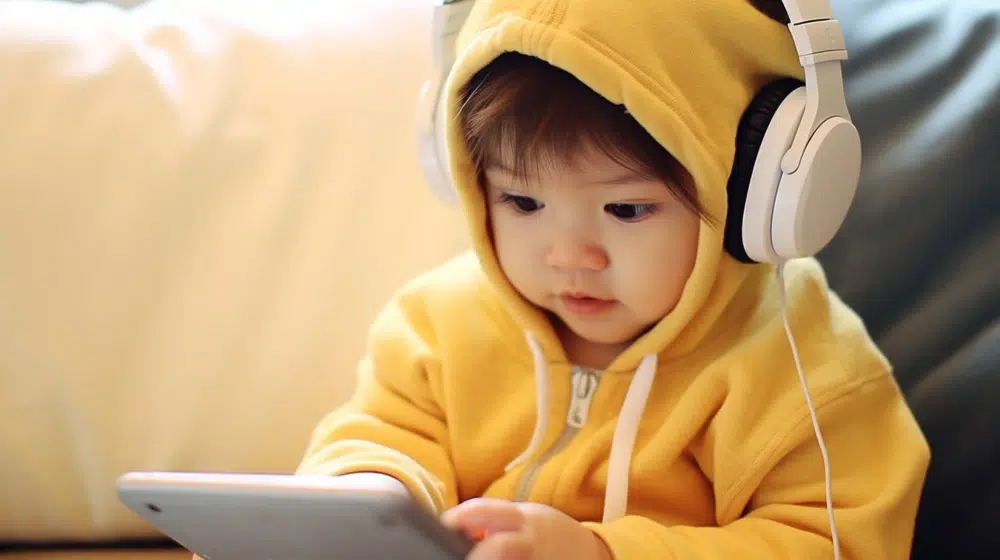The Reality of Gadget Use and Eye Health Risks in Children
Digital technology advancements over the past decade have altered how kids play, communicate, and learn. These days, both at home and at school, gadgets like laptops, tablets, and cellphones are commonplace.
Since online education was made available during the COVID-19 epidemic, children’s use of technological gadgets has grown dramatically. School-aged children spend three to six hours a day in front of a screen, either for learning or amusement, according to certain health and education data.
While there are numerous advantages to technology, there are drawbacks as well, particularly with regard to children’s eye health. Long-term usage of digital screens can lead to headaches, dry eyes, impaired vision, and eye fatigue. Furthermore, excessive device use is linked to a rise in children’s myopia, or nearsightedness, which is becoming more prevalent even at a young age.
Given that children’s visual systems are still developing, this risk is significantly higher. Youngsters frequently use electronics in awkward postures or in dimly lit environments, and they frequently lack the awareness necessary to recognize the symptoms of eyestrain.
This phenomena demonstrates how using a device can impact a person’s lifestyle as well as hinder a child’s development, particularly with regard to visual health. Therefore, in this age of constantly changing technology, it is essential that parents, educators, and medical professionals become aware of the risks to children’s eyesight and collaborate to protect them.
The Importance of Keeping Children’s Eyes Healthy Amid Digital Screen Exposure
Data from a number of education and health authorities show that children from elementary school through adolescence spend three to six hours a day in front of a screen, whether for learning, enjoyment, or social interaction.
This situation is made worse by the pervasive digitalization trend, which includes internet-based learning, which has become popular since the COVID-19 epidemic. More than ever before, kids are spending more time outside using electronic devices. This shift in activity habits has an effect on eye health in particular as well as general physical health.
The developing eyes of children are not prepared to focus on digital devices for extended periods of time or tolerate exposure to blue light. Consequently, even in early childhood, a variety of visual complaints are beginning to be identified.
It becomes crucial to maintain eye health in circumstances like these. Early vision impairment in children can have an impact on their general learning and development as well as their quality of life. Limiting device use, providing frequent eye breaks, and allowing children to play outside in natural light are all ways to safeguard them from harm at a young age.
On the other hand, as technology is becoming more and more integral to children’s social and academic life, it is impossible to merely prohibit or discourage its use. As a result, it’s critical to recognize that this problem is not only a technological one; it also involves parenting, parental awareness, and shared accountability across the community, school, and home.
In March 2025, a survey by PERDAMI and HOYA Vision Care in Jakarta found that 36.4% of junior high school students had visual impairment that required glasses, and 14% of them had severe myopia. On the other hand, data from 2023 in Jakarta found that 35–40% of elementary school students aged 9-12 years had nearsighted.
This rise is largely ascribed to kids’ propensity to spend excessive amounts of time staring at screens on electronic devices for amusement and online education, particularly in the wake of the epidemic.
Even though it has been demonstrated that outdoor activities greatly lower the incidence of myopia, reducing these activities actually makes the condition worse. If treatment is not received, this visual impairment can have an impact on children’s learning performance and general quality of life.
Overuse of Mobile Phones Increases Children’s Risk of Nearsightedness and Eye Strain
Children’s extensive use of electronics is leading to a number of severe eye health issues. One of the main concerns is the rising incidence of visual impairment, especially nearsightedness, which is currently one of the most prevalent children eye health issues in many nations, including Indonesia.
Children who stare at electronic device screens for extended periods of time without taking breaks are more likely to develop visual issues, according to studies. In addition to nearsightedness, parents and medical professionals frequently report a variety of other issues, including headaches from eye strain, impaired vision, dry eyes, and eye tiredness.
This syndrome is frequently caused by a number of circumstances, including the habit of using gadgets in non-ergonomic settings, inadequate lighting, and use that surpasses safe limits. Regretfully, a lot of parents and kids don’t know how to utilize technology properly. Because of this, eye conditions are frequently discovered and treated too late.
On the other hand, a lack of outdoor exercise also deteriorates children’s eye health. It has been demonstrated that children can prevent nearsightedness by playing outside and being exposed to natural light.
However, children are less likely to participate in outdoor activities due to modern lifestyles that are dominated by the usage of electronic gadgets. Therefore, eye health issues can result in long-term issues that impact children’s quality of life in the future, in addition to causing temporary discomfort.
Maintaining children’s eye health is a major concern for parents, educators, and medical professionals, particularly in light of the rapid advancement of technology and children’s growing reliance on devices. Therefore, practical measures are required to mitigate the detrimental effects of gadget use on children’s eye health.
How to Effectively Lower Children’s Risk of Eye Disorders from Gadget Use
A thorough strategy involving parents and educators is required to lessen the negative impacts of screen usage on kids’ eye health. One crucial step that can be taken is to limit the amount of time kids spend using electronics. According to experts, kids shouldn’t spend more than an hour or two a day on electronics.
Additionally, it’s critical to adhere to the recommended schedule of eye breaks. For instance, the 20-20-20 technique urges kids to look at a screen for twenty minutes before turning their attention to something six meters away. This lessens tiredness and tension on the eye muscles.
To adhere to ergonomic principles, it’s critical to take into account the device’s position and surroundings in addition to how long it takes to operate. Youngsters should sit up straight and maintain a distance of thirty to forty centimeters from the screen.
To avoid eye or neck strain, make sure the screen is level with the line of sight. Additionally, the lighting in the room should be just right—not too bright, not too dark—so that the eyes don’t have to work harder to focus. Maintaining eye health and lowering the chance of discomfort can be achieved by providing a comfortable environment.
Encouraging kids to play and engage in outdoor activities on a daily basis is also crucial. It has been demonstrated that exposing kids to natural light lowers their likelihood of developing nearsightedness.
Furthermore, outdoor exercise promotes the best possible development of the body and eyes. Given the modern lifestyle, which encourages kids to spend more time indoors using electronics, this practice is crucial.
Maintaining children’s eye health also heavily relies on awareness and education. Children need to learn from their parents and instructors the value of maintaining eye health, the risks of excessive gadget use, and how to use them responsibly. Children can be more disciplined in their time management and digital device use if they have a solid grasp.
Lastly, it is very advised to have a specialist examine the child’s eyes on a regular basis in order to track their eye health. Early identification of vision impairment enables appropriate therapy and averts the development of more severe diseases later on.
Though they live in this linked digital age, it is believed that children’s eye health can be preserved through a combination of screen time restriction, ergonomic positioning, outside activities, quality education, and routine health examinations.
According to Dr. Weni Puspitasari, SpM of VIO Optical Clinic, following the COVID-19 epidemic, a large number of school-age children have experienced visual impairments such nearsightedness and cylinder.
Eye exams, which have to be performed at least once a year, are crucial for spotting issues early and averting long-term harm to children’s quality of life, she said. Also, excessive use of electronic devices can hasten the development of eye diseases in children and teenagers, according to Dr. Niken Indah Nurwahyudiani, SpM from East Java Community Eye Hospital.
Younger patients will benefit more from early therapy since their eyes are still developing and can be fixed more readily, she added. Therefore, parents ought to make sure that their kids don’t spend all of their time using gadget. Additionally, individuals should make sure they routinely have a specialist examine their eyes.
Maintaining the Health of Children’s Eyes in the Digital Age: A Joint Duty
Given the speed at which technology is developing, children’s usage of devices has become an inevitable aspect of daily life.
Even though technology offers numerous advantages in the areas of education and entertainment, excessive usage without appropriate regulation can have detrimental effects, particularly on children’s eye health. Since issues like eye tiredness, nearsightedness, and other visual impairments are becoming more prevalent at younger ages, this is a problem that need attention.
Thus, in this digital age, preserving children’s eye health ought to be a top concern. Limiting screen time, adopting ergonomic device positions, boosting outdoor physical activity, and getting annual eye exams are all ways to prevent this. In order for parents and kids to utilize technology responsibly and healthily, education is equally essential.
Children may continue to grow and develop in the best possible way without having to compromise their eye health because of digital lifestyles provided everyone—family, school, and community—is aware of this and works together. Instead than causing health issues that hinder children’s progress, technology should be a tool that helps them in the future.
Author: Ivonia Putri Sidhinta
Arabic Education Department, Faculty of Islamic Studies, Universitas Muhammadiyah Pof. Dr. HAMKA
Supervisor: Muhammad Iman Sastra Mihajat, Ph.D
Editor: Salwa Alifah Yusrina
Bahasa: Rahmat Al Kafi
Ikuti berita terbaru Media Mahasiswa Indonesia di Google News















